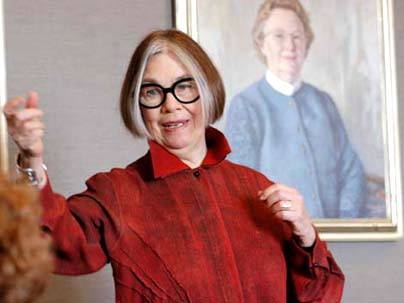Adele Santos, dean of the School of Architecture, presented an informal talk to the MIT Women's League that portrayed both the general changes in opportunities and roles for women in architecture and planning and her own enthusiasm for the profession.
Fresh from the "red-eye" flight that returned her to Cambridge from San Francisco and her firm, Santos Prescott and Associates, Santos spoke to the group assembled at noon in the Emma Rogers Room for about 40 minutes on Friday, Feb. 18.
A native of Cape Town, South Africa, Santos described her parents as encouraging and the educational and social life outside her home as a "reactionary milieu."
"A woman's place was in the home. A B.A. prepared you to be intelligent and married, and I was socialized to believe that women were artistic, not analytical. We weren't 'big thinkers.' We could design kitchens, but not be planners," she recalled.
A top student in South Africa (and frequently the only woman in her classes), Santos moved to London, receiving the A.A. diploma from the Architectural Association in 1961. "There were three women in my class. Then came the dramatic changes. By the time I got to the University of Pennsylvania, women were tops in all the technical subjects. Classes were 50 percent women," she said.
Santos received the master of architecture in urban design from Harvard University in 1963 and the master of architecture and master of city planning degrees from the University of Pennsylvania in 1968. She began practicing architecture that year, achieving renown for her range as a designer and her commitment to affordable housing and to a sustainable interplay between building design and civic life.
She told the attentive group that her path into the profession was once a routine entry for women. "I was married to a husband who was my partner. At the time there were very few women practitioners. After the seventies, we didn't hit the glass ceiling in school; we hit it in the profession," she said.
But all that has "completely transformed" in the past two decades, she said.
"Firms headed by women are growing, and they are getting projects because of being considered more responsive to clients, more interactive. More and more women are staying in the profession. Some are graduating, raising their children, and entering later. I am very optimistic about the significant role women will be playing in the profession," Santos said.
As dean of architecture, Santos described her goal is for MIT to be "THE destination school, the place that is pushing the edges of knowledge. There's no place like this on earth. I'm excited about building bridges with other parts of the campus, too, as professions involved with the environment start to merge and use the same techniques," she said.
Regarding her own experience, Santos noted that women of her generation entering any of the former "male bastions" like law or medicine made sacrifices in the face of inadequate accommodation to child-raising or family life. Having children was "one piece of your life you lopped off," she said.
Today, those sacrifices may not be necessary. But, said Santos with clear delight, architecture itself--the complex work, the competitive field, the long hours, the "red-eye" itself--remains demanding.
"Long hours? Of course," said Santos. "But what I say to young women today is, 'Don't worry about that! It's fun!'"
Dean Santos' recent projects
• Mission Bay Housing, a mixed-use building in San Francisco's Mission Bay development (2001)
• FuturePlex, a 1.3-million-square-foot development in San Francisco designed to be certified under the LEED rating system by the U.S. Green Building Council (2001)
• Light on Learning, a study funded by Pacific Gas & Electric to develop prototyes for day lighting in California schools (2000)
• Penn Children's Center, her winning project in a competition to design a child care center at the University of Pennsylvania
• New facitilities for the Please Touch Museum in Philadelphia (1998)
• Light on Learning, Artist's residence for Villa Montalvo in Saratoga, California (1998)
A version of this article appeared in MIT Tech Talk on March 2, 2005 (download PDF).






